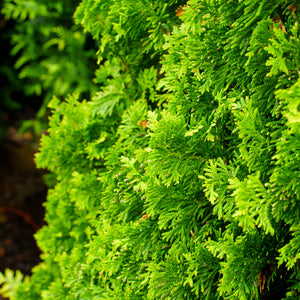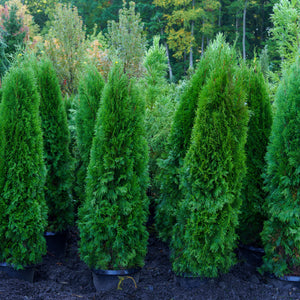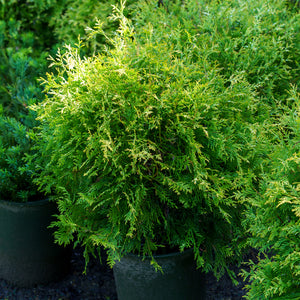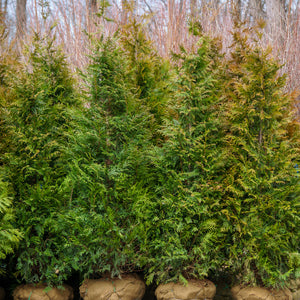The Arborvitae Guide
Arborvitae trees bring a timeless and evergreen beauty to any landscape. With their slender and elegant form, unique foliage, and remarkable adaptability, arborvitae trees are a captivating choice for enhancing gardens and outdoor spaces. These versatile trees belong to the Thuja genus and are renowned for their ability to thrive in various climates and soil conditions. Whether you desire a natural privacy screen, a striking focal point, or a vibrant addition to your garden, arborvitae trees offer endless possibilities to transform your outdoor environment. With proper planting and care, you can create a serene and enchanting landscape that will endure for years to come.
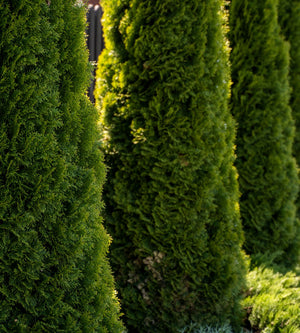
About
Arborvitae trees, part of the Thuja genus, encompass a diverse group of evergreen trees renowned for their timeless beauty and ecological significance. With a variety of recognized species, arborvitae trees are distributed across temperate regions of the Northern Hemisphere, including North America, Europe, and Asia.
These remarkable trees are characterized by their distinct features and important role in supporting local ecosystems. One of the defining characteristics of arborvitae trees is their dense foliage, which remains vibrant green throughout the year, providing year-round interest and privacy. The leaves of arborvitae trees are scale-like and arranged in flattened sprays, creating a unique and attractive texture.
Arborvitae trees play a significant ecological role by providing shelter and nesting sites for birds and small mammals. They also act as windbreaks, providing protection and reducing soil erosion.
Arborvitae trees are adaptable to various soil types and can tolerate both full sun and partial shade. Their moderate growth rate and low maintenance requirements make them a popular choice for landscaping projects.
Whether used as a natural privacy screen, a focal point in a garden, or a decorative addition to mixed borders, arborvitae trees bring a sense of enduring beauty and functionality to any landscape.
By incorporating arborvitae trees into your outdoor space and caring for them appropriately, you contribute to the preservation of these remarkable trees and the ecological balance they support.
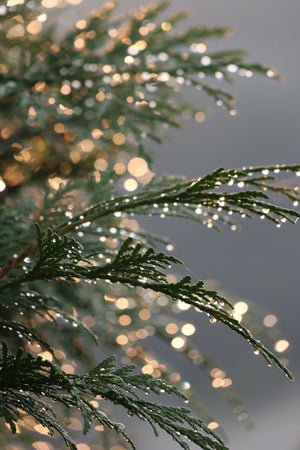
Planting
Arborvitae trees have specific planting requirements to ensure their successful establishment and growth. Here are some general guidelines for planting and caring for arborvitae trees:
Soil: Arborvitae trees thrive in well-drained soil that is rich in organic matter. They prefer a slightly acidic to neutral soil with a pH between 6.0 and 7.0. Prior to planting, prepare the site by loosening the soil and incorporating compost or organic matter to improve drainage and enhance soil fertility.
Sunlight: Arborvitae trees prefer full sun to partial shade. Choose a location that receives at least six hours of direct sunlight each day. However, they can tolerate some shade, particularly in regions with hot and dry climates.
Watering: Proper watering is essential for the initial establishment of arborvitae trees. After planting, water the tree deeply and thoroughly. Provide regular irrigation throughout the first year to ensure the roots have sufficient moisture. Water deeply once or twice a week, adjusting the frequency based on rainfall and soil moisture levels. Avoid overwatering, as it can lead to root rot.
Mulching: Apply a layer of organic mulch around the base of your arborvitae tree to conserve moisture, suppress weed growth, and regulate soil temperature. Use wood chips, bark, or compost as mulch, making sure to keep it a few inches away from the trunk to prevent excess moisture buildup and potential disease issues.
Pruning: Arborvitae trees generally require minimal pruning. However, you can trim or shape the tree as desired to maintain its form and size. Prune any dead or damaged branches during late winter or early spring while the tree is still dormant. Use clean and sharp pruning tools to minimize the risk of infections.
By following these basic planting and care guidelines, you can ensure the successful establishment and healthy growth of your arborvitae trees. With proper care, your arborvitae trees will thrive and enhance the beauty and privacy of your landscape for years to come.
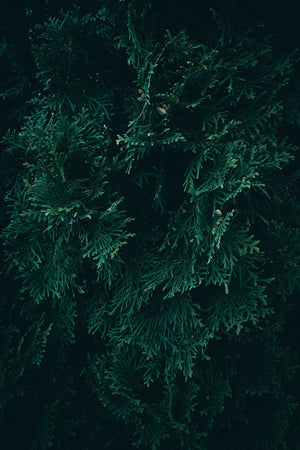
Care
Arborvitae trees require specific care to ensure their optimal growth and health. Here are some general guidelines for the care of arborvitae trees:
Watering: During the growing season, provide moderate watering to your arborvitae trees. Aim for about one inch of water per week, adjusting as needed based on rainfall. It's important to water deeply and thoroughly to promote deep root growth. Avoid shallow watering, which can lead to stress and dehydration. In periods of drought or high temperatures, additional watering may be necessary to keep the soil adequately moist.
Pruning: Arborvitae trees typically do not require extensive pruning. However, it's advisable to remove any dead or damaged branches to maintain the tree's overall health and appearance. You may also shape the tree to achieve the desired size and form. Prune during late winter or early spring before new growth emerges. Use clean, sharp pruning tools to minimize the risk of damaging the tree.
Fertilizing: Fertilizing can promote healthy growth and vigor in arborvitae trees. Apply a balanced, slow-release fertilizer in the spring or early summer, following the recommended application rates and timing provided by the manufacturer. Avoid over-fertilizing, as it can lead to excessive foliage growth and weak branches. It's best to follow a conservative approach and use less fertilizer if unsure.
Soil and Sunlight: Arborvitae trees thrive in well-drained soil that is rich in organic matter. They can adapt to various soil types, but ensuring good drainage is crucial for their optimal growth. Provide full sun to partial shade for arborvitae trees, with at least six hours of direct sunlight each day. Partial shade can be beneficial in hotter regions to protect the tree from excessive heat.
Mulching: Apply a layer of organic mulch around the base of your arborvitae tree to conserve moisture, suppress weed growth, and regulate soil temperature. Use wood chips, bark, or compost as mulch, keeping it a few inches away from the trunk to prevent moisture accumulation and potential rotting.
Pests and Diseases: While arborvitae trees are generally resistant to pests and diseases, it's important to monitor for common issues such as spider mites or fungal diseases like blight. Regularly inspect your tree for any signs of damage or disease and take appropriate measures if needed. Pruning away infected branches and maintaining overall tree health can help prevent and manage pest and disease issues.
By following these basic care guidelines, your arborvitae trees will thrive, providing beauty, privacy, and a sense of enduring elegance in your landscape for years to come.

How To Use
Arborvitae trees offer versatility and can be used in various ways to enhance your landscape. Here are some recommendations based on their characteristics:
Focal Point: Arborvitae trees make an excellent focal point in your landscape due to their timeless beauty and unique form. Plant a single arborvitae tree in a prominent location to create a striking centerpiece that adds depth and visual interest to your garden.
Privacy Screen: Utilize the dense foliage of arborvitae trees to create a natural privacy screen in your landscape. Plant them in a row along your property line or around your outdoor living spaces to establish an attractive and effective barrier that enhances privacy and creates a sense of seclusion.
Windbreak: Arborvitae trees can serve as a natural windbreak, thanks to their dense foliage and sturdy growth. Plant them strategically to create a windbreak that shields your garden, home, or outdoor seating areas from strong winds, providing a more comfortable and enjoyable outdoor environment.
Border or Hedge: Use arborvitae trees to create borders or hedges that define and accentuate different areas of your landscape. Their compact growth habit and year-round green foliage make them an ideal choice for creating structure and visual boundaries.
Container Planting: Due to their moderate size and slow growth rate, certain varieties of arborvitae trees can be planted in containers. This allows you to enjoy their beauty and versatility on patios, balconies, or in small gardens where space is limited.
Foundation Planting: Plant arborvitae trees near the foundation of your home to add greenery and softness to the architectural lines. They can provide an elegant backdrop and help visually integrate your house into the surrounding landscape.
Wildlife Habitat: Arborvitae trees attract various wildlife species, providing shelter and nesting sites for birds and small mammals. Their dense foliage also offers protection from predators. By planting arborvitae trees, you can create a thriving habitat that supports local wildlife and adds biodiversity to your garden.
When selecting arborvitae trees for your landscape, consider their specific growth habits, such as height and width, as well as their environmental requirements. Ensure they are planted in areas that receive adequate sunlight and provide well-drained soil. With their enduring beauty and functional benefits, arborvitae trees are a fantastic addition that will enhance the aesthetics and ecological balance of your outdoor space.
Conclusion
Arborvitae trees are a captivating and versatile addition to any landscape. With their timeless beauty, unique form, and ecological significance, arborvitae trees are highly valued for their aesthetic appeal and practical uses. By implementing proper planting and care practices, you can fully utilize the potential of arborvitae trees to enhance your outdoor space and create a lasting impact. Whether you desire a focal point or a natural screen, arborvitae trees can fulfill various roles in your landscape design. Plant a single arborvitae tree in a prominent location to draw attention and create a visually striking centerpiece, or line them up to establish a privacy screen that enhances seclusion and adds beauty. Arborvitae trees also serve as effective windbreaks, protecting your garden or outdoor living spaces from strong winds. Their compact growth habit and year-round green foliage make them an ideal choice for borders, hedges, or container planting. Additionally, arborvitae trees provide shelter and nesting sites for wildlife, contributing to the ecological balance of your garden. By incorporating arborvitae trees into your landscape, you create an enchanting habitat that supports local wildlife and adds vibrancy to your outdoor environment. With their enduring beauty, practical benefits, and ecological significance, arborvitae trees bring joy and a sense of tranquility to your outdoor space.




